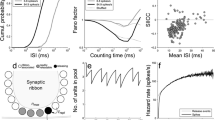Abstract
The functioning of the auditory system can be described as performing with a certain time constant, a frequency analysis of the incoming signals. Such an analysis means that frequency selectivity and time resolution are closely linked. It has led in practice to the use of narrow-band signals for the determination of the frequency selectivity and of wide-band signals (noise or clicks) for the determination of the temporal acuity. The use of suchs signals avoids the interactions as much as possible and makes it difficult to determine the effects of frequency selectivity and temporal resolution on each other.
Access this chapter
Tax calculation will be finalised at checkout
Purchases are for personal use only
Preview
Unable to display preview. Download preview PDF.
Similar content being viewed by others
References
Bechly, M. Fasti, H. (1982). Interaktion der Nachhoerschwellen-Tonheits-Zeitmuster zweier maskierender Schalle. Acustica 50: 70–74
Fastl, H. (1979). Temporal masking effects: III. Pure tone masker. Aoustioa 43: 282–294
Houtgast, T. (1974). Lateral suppression in hearing, Thesis, VU-Amsterdam Johnson-Davies, J., Patterson, R.D. (1979). Psychophysical tuning curves: restrietins the listening band to the signal region. J. Acoust. Soc. Amer. 79: 765–770
Moore, B.C.J. (1980). Detection cues in forward masking. In: Psyohophysteal, Physiological and Behavioural studies in Eeccring. Delft Un. Press
Plomp, R. (1964). Rate of decay of auditory sensation. J.A.S.A. 36: 277–282
Small, A.M. (1959). Pure tone masking. J. Acoust. Soc. Amer. 31: 1619–1625
Terry, M., Moore, B.C.J. (1977) “Suppression” effects in forward masking. J. Acoust. Soc. Am. 62: 781–784(L)
Verschuure, J. (19Bi). Pulsation patterns and nonlinearity of auditory tuning.
II. Analysis of psychophysical results. Acustica 49: 296–306
Verschuure, J., Brocaar, M.P. (1983). Detection thresholds in pulsation measurement, Proc. 11th ICAS Paris
Verschuure, J., Rodenburg, M., Maas, A.J.J. (1976). Presentation conditions of the pulsation threshold method. Acustica 35: 47–54
Zwicker, E. (1974). On a psychoacoustical equivalent of tuning curves. In: Facts and Models in Hearing. Springer Verlag
Author information
Authors and Affiliations
Editor information
Editors and Affiliations
Rights and permissions
Copyright information
© 1983 Springer-Verlag Berlin Heidelberg
About this paper
Cite this paper
Verschuure, J., Kroon, J.N., Brocaar, M.P. (1983). Decay of Pulsation Threshold Patterns. In: Klinke, R., Hartmann, R. (eds) HEARING — Physiological Bases and Psychophysics. Springer, Berlin, Heidelberg. https://doi.org/10.1007/978-3-642-69257-4_43
Download citation
DOI: https://doi.org/10.1007/978-3-642-69257-4_43
Publisher Name: Springer, Berlin, Heidelberg
Print ISBN: 978-3-642-69259-8
Online ISBN: 978-3-642-69257-4
eBook Packages: Springer Book Archive




